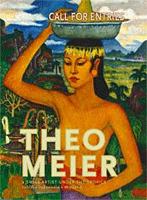
“Who is Theo Meier?” a foreign friend asked me recently, when watching some expressionistic paintings during a recent exhibition about Burmese Art at Chiang Mai’s University Art Museum.
“Don’t you know the world-famous Swiss artist, who lived in a big teakwood compound along the Mae Ping River more than some 25 years ago?” I replied and tried digging in the past thereafter.
Theo Meier was born on 31 March 1908 in Basle at the Rhine River and within the busy triangle area of France, Germany and Switzerland. Being twenty years old, he got a scholarship at the School of Art in Basle and tried to make a living with portrait-paintings. Though visiting the contemporary art centres of Berlin and Dresden, Theo Meier got his life-long inspirations through a “Gauguin” art exhibition back home. In 1932, he organised his own exhibition in Basle’s Elisabethenstrasse and friends sponsored his sea voyage to Tahiti via the Panama Canal. Via China, Singapore, and Cairo, he returned to Basle in 1934, just to be back in Singapore again, and finally reaching Bali in 1936.
In Bali, Theo Meier found what was his dream after all these formative years: Returning to simplicity, purity, and nature - having “Rousseau” in the back of his head. Besides, the ritual songs and dances of Bali inspired him to even further heights. Settling at first in Sanur, Theo Meier married a Balinese girl and frequented Ubud, where the German painter Walter Spiess lived since 1925. The marriage broke up after five years in 1941. During the Japanese occupation the painter had lost all his work. Theo Meier’s second marriage was more successful. His Balinese wife Made Pergi gave birth to a daughter in 1948, but left him later for a young musician. In 1955, the painter returned to Switzerland.
But the tropics got him back. In December 1959, Theo Meier was invited to visit Prince Sanidh Rangsit in Hua Hin, Thailand. There he met his future wife La-iad and moved to Chiang Mai, where they got married in 1964. They first settled down in a small house in the Wat Suan Dok area and bought land along the Ping River. Building up a representative compound made of teakwood houses took years and the house-warming ceremony on 10 February 1972 is still remembered. Ten years later, he succumbed to bone cancer and peacefully died in hospital at Bern, Switzerland on 19 June 1982. The following Buddhist 100- day ceremony thereafter was done in his housing estate along the Ping River and guided by the German monk Phra Santi from Wat Umong. 25 years later, the compound is still there and a red sign is leading the way to house number 54 at the end of Soi 4 in Faham next to Wat Sansai Tonkok.
During all the years in Chiang Mai, Theo Meier used to travel back and forth between Chiang Mai and Bali. Also, he was often seen in company with the German painter Gerd Barkowsky in a local restaurant drinking his favourite “Maekhong Soda” with lemon. His cooking capabilities were legendary. Closer looks into his still existing library show his strong interest on the life and culture of the hill tribes in Northern Thailand. All in all, Theo Meier knew how to live and always made the best of things. His life’s work is inestimable.
On a recent visit to Mrs. La-iad, who cares for all things Theo Meier, she noted that a book launch is in the pipeline. Hexart Publishing in Jakarta, Indonesia, will introduce “The Life and Works of the Swiss artist Theo Meier (1908-1982)” in September 2007. According to Mrs. La-iad, some of his paintings sell for 10 million Thai Baht. As the plan to establish a “Theo Meier Museum” in Chiang Mai will be too costly, Mrs. La-iad is now preparing to sell the whole 2-rai compound for around 120 million Thai Baht. For that, she already moved to a new compound up the river since 2006. And the 100-year anniversary of Theo Meier’s birth is just around the corner in 2008. Thus, death it seems is just an illusion.
For further information, please contact Reinhard Hohler by e-mail.
 Вильгельм Телль
Вильгельм Телль























